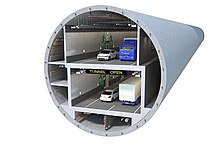 A visualization of the tunnel | |||||
| Overview | |||||
|---|---|---|---|---|---|
| Location | Seattle, Washington, U.S. | ||||
| Coordinates | 47°36′37″N 122°20′41″W / 47.61028°N 122.34472°W | ||||
| Status | Open | ||||
| Route | |||||
| Start | South Dearborn Street 47°35′48″N 122°20′09″W / 47.596534°N 122.335699°W | ||||
| End | Harrison Street 47°37′14″N 122°20′41″W / 47.620520°N 122.344674°W | ||||
| Operation | |||||
| Work begun | July 30, 2013[1] | ||||
| Constructed | 2013–2017 | ||||
| Opened | February 4, 2019 | ||||
| Operator | Washington State Department of Transportation | ||||
| Toll | $1.20 to $4.70 | ||||
| Technical | |||||
| Length | 9,270 feet (2,830 m; 1.756 mi)[2][3] | ||||
| No. of lanes | 4 | ||||
| Operating speed | 45 mph (72 km/h) | ||||
| Tunnel clearance | 15 ft 9 in (4.8 m) | ||||
| Width | 52 ft (16 m) | ||||
| |||||
The State Route 99 tunnel, also known as the Alaskan Way Viaduct replacement tunnel, is a bored highway tunnel in the city of Seattle, Washington, United States. The 2-mile (3.2 km), double-decker tunnel carries a section of State Route 99 (SR 99) under Downtown Seattle from SoDo in the south to South Lake Union in the north.
Since the 2001 Nisqually earthquake, the replacement of the Alaskan Way Viaduct had been the source of much political controversy demonstrating the Seattle process. Options for replacing the viaduct, which carried 110,000 vehicles per day, included replacing it with a cut-and-cover tunnel or a bored tunnel, replacing it with another elevated highway, or eliminating it while modifying other surface streets and public transportation. The current plan emerged in 2009 when government officials agreed to a deep-bore tunnel.
Construction began in July 2013 using "Bertha", at the time the world's largest-diameter tunnel boring machine. After several delays, tunnel boring was completed in April 2017, and the tunnel opened to traffic on February 4, 2019.
- ^ Cite error: The named reference
KN13was invoked but never defined (see the help page). - ^ "Tunneling toward a new SR 99; The SR 99 tunnel route (map)". Washington State Department of Transportation. Archived from the original on December 10, 2012. Retrieved December 8, 2012.
- ^ "Follow Bertha". Washington State Department of Transportation. Retrieved December 25, 2018.
